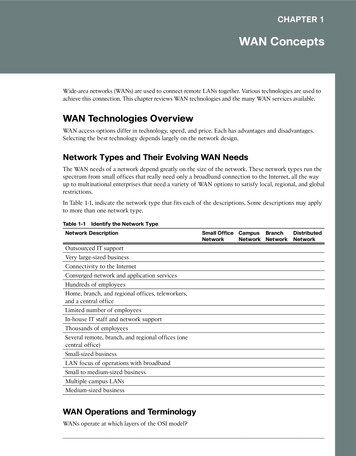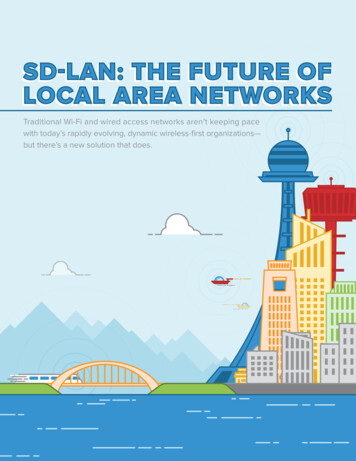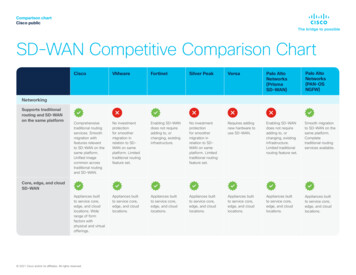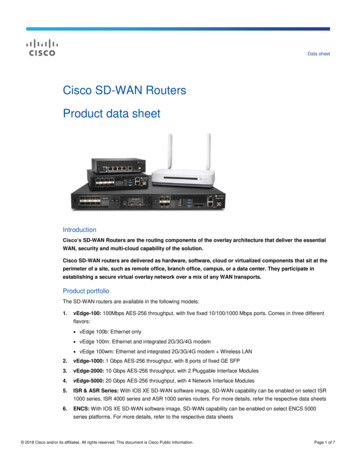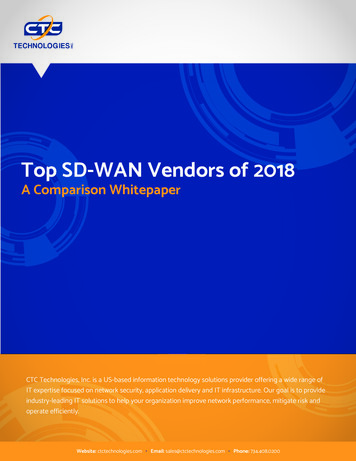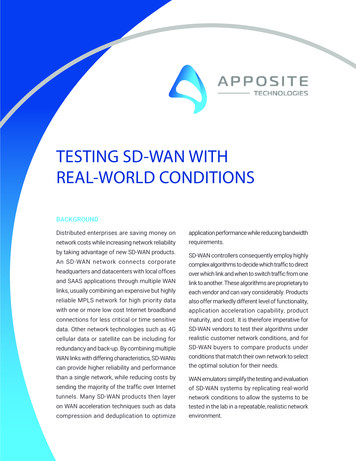
Transcription
TESTING SD-WAN WITHREAL-WORLD CONDITIONSBACKGROUNDDistributed enterprises are saving money onapplication performance while reducing bandwidthnetwork costs while increasing network reliabilityrequirements.by taking advantage of new SD-WAN products.An SD-WAN network connects corporateheadquarters and datacenters with local officesand SAAS applications through multiple WANlinks, usually combining an expensive but highlySD-WAN controllers consequently employ highlycomplex algorithms to decide which traffic to directover which link and when to switch traffic from onelink to another. These algorithms are proprietary toeach vendor and can vary considerably. Productsreliable MPLS network for high priority dataalso offer markedly different level of functionality,with one or more low cost Internet broadbandapplication acceleration capability, productconnections for less critical or time sensitivematurity, and cost. It is therefore imperative fordata. Other network technologies such as 4GSD-WAN vendors to test their algorithms undercellular data or satellite can be including forrealistic customer network conditions, and forredundancy and back-up. By combining multipleSD-WAN buyers to compare products underWAN links with differing characteristics, SD-WANsconditions that match their own network to selectcan provide higher reliability and performancethe optimal solution for their needs.than a single network, while reducing costs byWAN emulators simplify the testing and evaluationsending the majority of the traffic over Internetof SD-WAN systems by replicating real-worldtunnels. Many SD-WAN products then layernetwork conditions to allow the systems to beon WAN acceleration techniques such as datatested in the lab in a repeatable, realistic networkcompression and deduplication to optimizeenvironment.
WHAT IS A WAN EMULATOR?Application performance is impacted not only by theavailability of sufficient bandwidth, but by the latencycaused by the distance between the sites and packet losscaused by signal errors and congestion. Other networkimpairments such as short outages, reordered packets,packet fragmentation, etc. can also have a huge impact onapplication usability. Whitepaper 1 For example, a typicalfile transfer over a high-speed 1 Gbps link may be limitedby cross-country latency of 120 ms to a throughput ofless than 100 Mbps, only 10% of the available bandwidth.If only 0.1% of the packets, or one out of every thousandpackets are lost over the network, throughput is furtherreduced to only 5 Mbps.and other conditions of the network so that applicationperformance can be validated in the lab. Essentially,packets that pass through a WAN emulator appearexactly as if they traveled across the WAN. This allowsapplication performance between two sites to be testedsimply by attaching a client and server device (or networkof devices) to the two ports of the WAN emulator andsetting the conditions to match the real-world network.Application throughput, responsiveness, and quality canthen be evaluated and measured.Many WAN emulators also include the ability to profile livenetwork conditions and automatically reproduce thosedynamically changing conditions within the test system.A WAN emulator replicates the bandwidth, latency, lossTESTING SD-WANS WITH A WAN EMULATORBy replicating the real-world network in the lab, WANemulators are an invaluable tool to test and optimizeSD-WAN systems and optimize their configurations.Figure 1 shows a typical SD-WAN network connectinga local office to the corporate data center and internetSAAS providers.In this example, the local office has three separate networkconnections, an MPLS network for high-priority traffic, alow-cost broadband Internet connection for lower prioritytraffic, and a 4G cellular data connection for backup.SAAS servers can be reached directly over the Internetlink or through the wireless network without having toconnect through the data center.This SD-WAN example can be simulated in the WAN emulatorby configuring three separate paths, one for each networkconnection, as shown in Figure 2. Initial WAN conditionscan be set to determine application performance undernormal conditions. The WAN conditions can then be varieddynamically to see how the SD-WAN system reacts to networkoutages, congestion, excessive packet loss and other factorsand measure how they affect application performance.SAAS PROVIDERBRANCH OFFICESWIRELESSINTERNETMPLSENTERPRISE DATA CENTERWireless: 171ms delay, 2.9ms jitter, .25% lossInternet: 94ms delay, 2.4ms jitter, .1% lossMPLS: 60ms delay, .3ms jitter, .01% lossFigure 1. Typical SD-WAN Configuration02
SAAS PROVIDERSSIMULATEDBRANCH OFFICEWAN EMULATORWirelessInternetMPLSSD-WAN DEVICESD-WAN DEVICEWireless: 171ms delay, 2.9ms jitter, .25% lossInternet: 94ms delay, 2.4ms jitter, .1% lossMPLS: 60ms delay, .3ms jitter, .01% lossSIMULATEDDATACENTERFigure 2. Simulate SD-WAN using a WAN EmulatorSD-WAN IMPAIRMENT TESTINGNetwork impairments are introduced on the test networkpath switching that decreases performance.using a WAN emulator to test how SD-WANs respond tonetwork conditions through link failover, packet steering,and prioritization, and how those changes impact theapplication end user experience. Test conditions include: Network Outage/Packet loss and Link Failover.SD-WAN controllers must determine when linksare down and failover to secondary links or backup connections. To test these algorithms, theIncreased latency and jitter. Latency and jitterWAN emulator is used to apply packet loss orare increased in the WAN emulator for thecreate network outages for of varying lengths.primary link beyond the SD-WAN programmedthreshold. The SD-WAN controller should detectthe impairment and determine whether it is amomentary blip due to congestion or a longerterm degradation and decide whether to switchthe traffic to the other the WAN links. Thecontroller then needs to be able to detect theDetecting whether a physical link is up or down issimple, but when an intermediate hop somewherein the network loses a few consecutive packets,determining whether this is due to a link outageor just momentary queue overflows is difficult.return to nominal conditions and switch trafficLink outages might be only a few millisecondsback to the primary link.in length, which could be ignored if they happenonly once, but recur regularly, causing seriousAs shown in Figure 3, on a second-by-secondperformance degradation. Links may not be fullybasis, latency often varies by tens or hundredsdown but simply experience high loss rates orof milliseconds on typical Internet links and byeven more on wireless networks. Separating thesignal of a significant and detrimental increase inlatency from the noise of regular variability can bechallenging. Since switching traffic from one pathto another can cause detrimental performanceimpacts, the SD-WAN controller needs tomaintain a delicate balance betweenreacting quickly to network impairmentstoimprove performance and excessivecause data corruption. Deciding when to switchto a failover link can be a complicated decision,and determining when the outage event is overto switch back to the original link is even moredifficult. Again, since switching traffic to adifferent link carries its own performance cost,the end user experience can be hurt by either notswitching quickly enough or switching paths toofrequently.03
Figure 3. Second-by-Second Latency of Cross-Country Internet WAN Congestion. When congestion occurs on thenetwork, many SD-WAN controllers prioritizetraffic to optimize the performance of importantand time-sensitive data. The WAN emulator isused to simulate bandwidth constraints on eachlink, as well as background traffic that can causecongestion to test the effectiveness of this SDWAN functionality. Link aggregation. The bandwidth on multiplelinks between the same destinations can bebonded to aggregate available capacity. However,if packets from the same flow travel over differentlinks, they will arrive out of order which can havea disastrous effect on application performance.If this feature is part of the SD-WAN system,sufficient traffic should be generated to checkapplication performance when traffic is splitbetween multiple paths. Automation capabilities. SD-WAN controllersmay allow user-programmed responses tonetwork impairments. For example, accessto Netflix and Facebook might be limitedduring periods of network congestion.WAN emulators can be used to changeor create congestion or other triggering events toensure proper operation of these features. Figure3. Second-by-Second Latency of Cross-CountryInternet WAN Connection 4 Figure 4. Example oftraffic monitoring with Netropy WAN Emulator Application aware routing. Many SD-WANcontrollers can prioritize traffic based onapplication and protocol type, filtering thetraffic to different links based on costs,performance, and capacity. The WAN emulatorcan be configured to match the conditions of thedifferent links to validate acceptable end userexperience for the many different applicationsthat users depend on. Application acceleration. Many SD-WAN systemsoffer a variety of application accelerationand WAN optimization techniques includingcompression, deduplication, caching, TCPoptimization, and applicationspecific proxying.The WAN emulator allows users to test theefficacy of these optimizations for differentapplications and a variety of real-world networkconditions.04
Figure 4. Example of traffic monitoring with Netropy WAN EmulatorCONCLUSIONSD-WANs enable optimal use of WAN links that connect the enterprise to increase capacity and reliability while reducing costs.However, SD-WANs are highly complex systems managing mission-critical network. Extensive testing is required to select theSD-WAN system for the user’s specific network conditions, application mixture, and budget, and ensure proper operation duringboth anticipated and unanticipated situations. WAN emulators are a critical test tool to benchmark SD-WAN systems underreal-world network conditions products prior to vendor selection and to perform reliability testing and optimization prior todeployment.ABOUT APPOSITE TECHNOLOGIESApposite is the leader in WAN emulation. Apposite’s Netropy and Linktropy WAN emulators simulate the bandwidth, latency, lossand other network conditions to validate application performance in a repeatable test environment. Distinguished by industry-bestease-of-use and unmatched value, Apposite’s WAN emulators are widely utilized by SD-WAN equipment developers and enterpriseIT teams to benchmark and optimize the performance of SD-WAN systems under real-world conditions.17835 Ventura Blvd Suite 211, Los Angeles, CA 91316 USAwww.apposite-tech.com TEL: 1.310.477.9955 info@apposite-tech.comCopyright 2018 Apposite Technologies LLC. All rights reserved. Apposite, Linktropy and Netropy are registeredtrademarks of Apposite Technologies.The Apposite logo and “WAN emulation made easy” are trademarks of Apposite Technologies. ( P/N: DOC-DSNNE-071 )
TESTING SD-WANS WITH A WAN EMULATOR By replicating the real-world network in the lab, WAN emulators are an invaluable tool to test and optimize SD-WAN systems and optimize their configurations. Figure 1 shows a typical SD-WAN network connecting a local office to the corporate data center and internet SAAS providers.


